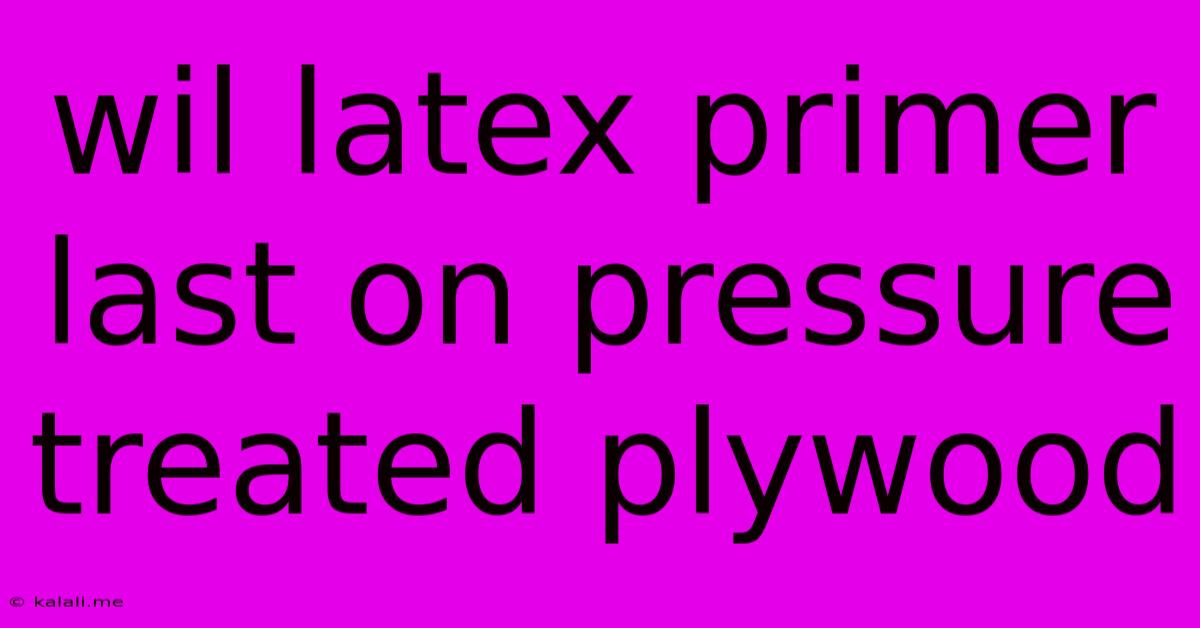Wil Latex Primer Last On Pressure Treated Plywood
Kalali
May 23, 2025 · 3 min read

Table of Contents
Will Latex Primer Last on Pressure Treated Plywood? A Comprehensive Guide
Meta Description: Discover if latex primer is suitable for pressure-treated plywood. Learn about the challenges, preparation techniques, and the best primers for long-lasting results. This guide helps you achieve a durable and aesthetically pleasing finish on your project.
Pressure-treated plywood offers durability and weather resistance, making it ideal for outdoor projects. But before applying your final coat of paint or stain, a primer is crucial for adhesion and longevity. Many homeowners wonder: will latex primer last on pressure treated plywood? The answer isn't a simple yes or no. It depends on several factors, including proper preparation and the type of primer used.
Understanding the Challenges of Pressure-Treated Plywood
Pressure-treated wood contains preservatives, often copper-based compounds, designed to protect against rot and insect damage. These preservatives can interfere with paint adhesion. The chemicals can leach out over time, causing paint to peel or blister. Moreover, the wood itself can be quite porous, requiring a primer that effectively seals the surface and prevents the absorption of subsequent coats. Ignoring these factors can lead to premature paint failure and wasted time and resources.
Preparing Pressure-Treated Plywood for Priming
Proper preparation is paramount for a successful finish. This significantly impacts the longevity of your latex primer and the final paint job. Here's a step-by-step guide:
- Allow Sufficient Curing Time: Newly pressure-treated plywood needs adequate time to cure before priming. This typically ranges from several weeks to months, depending on the specific treatment and environmental conditions. Check with the manufacturer for precise recommendations. Rushing this step can compromise the adhesion of the primer.
- Cleaning the Surface: Remove any dirt, dust, debris, or mildew using a stiff brush, pressure washer, or a combination of both. Ensure the surface is completely clean and dry before proceeding.
- Sanding (Optional but Recommended): Light sanding can help improve the surface smoothness and enhance primer adhesion. Focus on removing any splinters or rough patches. Use fine-grit sandpaper to avoid damaging the wood.
- Neutralizing the Wood: Some sources recommend neutralizing the wood's chemicals using a wood wash or trisodium phosphate (TSP) solution, followed by thorough rinsing. This step helps to minimize the interaction between the preservatives and the primer. However, the necessity of this step is debated among professionals, and careful consideration is needed.
Choosing the Right Primer
Not all primers are created equal. For pressure-treated plywood, selecting the appropriate primer is crucial for long-term success.
- Oil-Based Primers: Traditionally, oil-based primers were favored for pressure-treated wood due to their superior sealing properties. However, they have strong odors, longer drying times, and are less environmentally friendly.
- Latex Primers: Modern latex primers, particularly those specifically formulated for exterior use and wood surfaces, have greatly improved. Look for primers labeled as "stain-blocking" or "alkyd-modified" to enhance adhesion and durability. These offer a good balance of performance, convenience, and reduced environmental impact.
- Specialty Primers: Consider specialized primers designed for pressure-treated lumber. These are formulated to minimize the interaction with wood preservatives and enhance paint adhesion.
Application Techniques
Proper application techniques are vital for a successful and long-lasting finish.
- Thin Coats: Apply thin, even coats to prevent runs and drips. Multiple thin coats are better than one thick coat.
- Allow Sufficient Drying Time: Allow each coat of primer to dry completely before applying the next coat, following the manufacturer's recommendations.
- Proper Tools: Use a high-quality brush, roller, or sprayer for even application.
Conclusion: Latex Primer on Pressure-Treated Plywood - Yes, But with Caution
While latex primer can be used successfully on pressure-treated plywood, meticulous preparation and the selection of a high-quality, exterior-grade primer are essential. By following these steps, you'll significantly increase the chances of a long-lasting and beautiful finish on your project. Remember to always consult the manufacturer's instructions for your specific primer and plywood. With careful attention to detail, you can achieve the desired results and enjoy your outdoor project for years to come.
Latest Posts
Latest Posts
-
So Why Dont You Kill Me
May 24, 2025
-
God Will Give You The Desires Of Your Heart
May 24, 2025
-
What Will Determine Whether Something Melts Or Freezes
May 24, 2025
-
What Does Shin Mean In Japanese
May 24, 2025
-
You Have Typed In An Erroneous Username Or Password
May 24, 2025
Related Post
Thank you for visiting our website which covers about Wil Latex Primer Last On Pressure Treated Plywood . We hope the information provided has been useful to you. Feel free to contact us if you have any questions or need further assistance. See you next time and don't miss to bookmark.